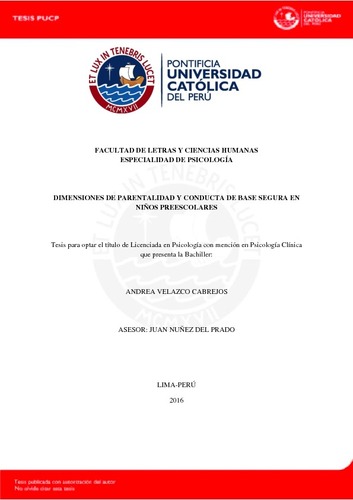Dimensiones de parentabilidad y conducta de base segura en niños preescolares
Abstract
La presente investigación tiene como propósito explorar si existe relación entre las dimensiones calidez, monitoreo y disciplina de la parentalidad y la conducta de base segura en niños en edad preescolar de Lima Metropolitana. Para ello, se evaluó a 20 niños con edades entre 42 y 72 meses (M = 60.25, DE = 8.30), junto con sus madres, con edades entre 24 y 42 años (M = 34.65, DE=5.56). Se empleó el instrumento Attachment Q-Set 3.0 (Waters, 1995) para medir la conducta de base segura y el Cuestionario de Parentalidad Mexicano (Halgunseth e Ispa, 2012) para evaluar las dimensiones de parentalidad. Los resultados sugieren que no existe evidencia de relación entre la conducta de base segura y las dimensiones de parentalidad. Adicionalmente, respecto al primer objetivo específico se encontró que no hay evidencia de diferencia entre las dimensiones de parentalidad según el sexo del niño. Sin embargo, se encontró que las niñas tienen puntuaciones mayores que los niños en el nivel global de seguridad y en la sub-escala Calidez en las interacciones con la madre. En cuanto al segundo objetivo específico, no se halló evidencia de diferencia en las dimensiones de parentalidad según el grado de instrucción de la madre. No obstante, se encontró que los niños de madres con estudios superiores tienen puntajes mayores en el nivel global de apego y en la sub-escala Calidez en la interacción con la madre, a diferencia de los niños con madres que tienen solo estudios secundarios. This research aims to explore wheather there is a relationship between the dimension warmth, monitoring, discipline of parenting and attachment security in preschoolers in Lima. To do this, 20 children aged between 42 and 72 months (M=60.25, SD=8.3) were tested along with their mothers, aged between 24 and 42 years (M=34.65 SD=5.56). The Attachment Q-set 3.0 (Waters, 1995) instrument was used to measure baseline attachment security, and the Mexican Parenting Questionnaire (Halgunseth and Ispa, 2012) was used to assess the dimensions of parenting. The results suggest that there is no evidence of a relationship between base security behavior and dimensions of parenting. In addition, in regard to the first specific objective, it was found, that there is no difference between dimensions of parenting according to the gender of the child. However, it was found that girls have higher scores than boys in the overall level of security and in the subscale of warmth of interaction with the mother. As for the second specific objective, no evidence of difference was found between the dimensions of parenting of the educational level of the mother. However, it was found that children of mothers with higher education have higher scores on the overall level of attachment and the subscale for warmth of interactions with the mother, unlike children whose mothers have only a high school education.
Temas
Apego.
Psicología infantil.
Conducta (Psicología).
Psicología infantil.
Conducta (Psicología).
Para optar el título de
Licenciado en Psicología Clínica






